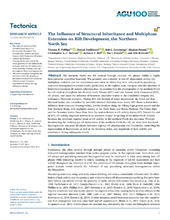| dc.contributor.author | Phillips, Thomas B. | |
| dc.contributor.author | Fazlikhani, Hamed | |
| dc.contributor.author | Gawthorpe, Rob | |
| dc.contributor.author | Fossen, Haakon | |
| dc.contributor.author | Jackson, Christopher Aiden Lee | |
| dc.contributor.author | Bell, Rebecca E. | |
| dc.contributor.author | Faleide, Jan Inge | |
| dc.contributor.author | Rotevatn, Atle | |
| dc.date.accessioned | 2020-05-11T08:32:19Z | |
| dc.date.available | 2020-05-11T08:32:19Z | |
| dc.date.issued | 2019-11-08 | |
| dc.Published | Phillips T, Fazlikhani H, Gawthorpe R L, Fossen H, Jackson CAL, Bell RE, Faleide JI, Rotevatn A. The influence of structural inheritance and multiphase extension on rift development, the northern North Sea. Tectonics. 2019;38(12):4099-4126 | eng |
| dc.identifier.issn | 1944-9194 | en_US |
| dc.identifier.issn | 0278-7407 | en_US |
| dc.identifier.uri | https://hdl.handle.net/1956/22174 | |
| dc.description.abstract | The northern North Sea rift evolved through multiple rift phases within a highly heterogeneous crystalline basement. The geometry and evolution of syn‐rift depocenters during this multiphase evolution and the mechanisms and extent to which they were influenced by preexisting structural heterogeneities remain elusive, particularly at the regional scale. Using an extensive database of borehole‐constrained 2D seismic reflection data, we examine how the physiography of the northern North Sea rift evolved throughout late Permian‐Early Triassic (RP1) and Late Jurassic‐Early Cretaceous (RP2) rift phases, and assess the influence of basement structures related to the Caledonian orogeny and subsequent Devonian extension. During RP1, the location of major depocenters, the Stord and East Shetland basins, was controlled by favorably oriented Devonian shear zones. RP2 shows a diminished influence from structural heterogeneities, activity localizes along the Viking‐Sogn graben system and the East Shetland Basin, with negligible activity in the Stord Basin and Horda Platform. The Utsira High and the Devonian Lomre Shear Zone form the eastern barrier to rift activity during RP2. Toward the end of RP2, rift activity migrated northward as extension related to opening of the proto‐North Atlantic becomes the dominant regional stress as rift activity in the northern North Sea decreases. Through documenting the evolving syn‐rift depocenters of the northern North Sea rift, we show how structural heterogeneities and prior rift phases influence regional rift physiography and kinematics, controlling the segmentation of depocenters, as well as the locations, styles, and magnitude of fault activity and reactivation during subsequent events. | en_US |
| dc.language.iso | eng | eng |
| dc.publisher | Wiley | en_US |
| dc.rights | Attribution CC BY | eng |
| dc.rights.uri | http://creativecommons.org/licenses/by/4.0/ | eng |
| dc.title | The influence of structural inheritance and multiphase extension on rift development, the northern North Sea | en_US |
| dc.type | Peer reviewed | |
| dc.type | Journal article | |
| dc.date.updated | 2020-01-13T05:52:50Z | |
| dc.description.version | publishedVersion | en_US |
| dc.rights.holder | Copyright 2019 The Author(s) | en_US |
| dc.identifier.doi | https://doi.org/10.1029/2019tc005756 | |
| dc.identifier.cristin | 1766243 | |
| dc.source.journal | Tectonics | |
| dc.relation.project | Norges forskningsråd: 215591 | |
| dc.relation.project | VISTA: vista | |

